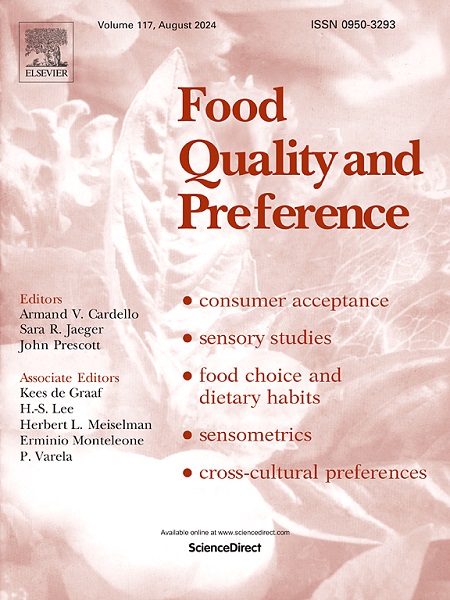Measurement and evaluation of participant response consistency in Case 1 Best-Worst-Scaling (BWS) in food consumer science
IF 4.9
1区 农林科学
Q1 FOOD SCIENCE & TECHNOLOGY
引用次数: 0
Abstract
Best-Worst Scaling (BWS) is well suited to survey research, and since this way of collecting data is gaining popularity, it is likely that applications of BWS, especially online, will increase. Despite the many advantages of online surveys, there is a growing awareness that particular attention needs to be given to data quality including the identification and elimination of ’bad respondents’. Post hoc data cleaning is the focus of the present research, which in the context of Case 1 BWS (object case) was directed to two indices of participant response consistency – root likelihood (RLH) and normalised error variance (ErrVarNorm), where the latter was newly developed. Across 18 studies in food consumer science, the two indices are applied, compared and evaluated. It is possible to apply both indices to the data, but if only a single index is to be used, the ErrVarNorm index is recommended because it is easy to calculate, directly measures response consistency and is logically coherent. ErrVarNorm ranges from 0 to 1, where higher values indicate greater response consistency. When excluding participants based on ErrVarNorm < 0.3, between 0 % and 12.4 % of participants were excluded (mean = 5.75 %), while ErrVarNorm < 0.5 led to between 0 % and 23.8 % of participants being excluded (mean = 13.1 %). Excluded participants were more likely to be men and below the age of 45 years old. The impact on study conclusions when excluding participants based on ErrVarNorm < 0.5 were illustrated for three studies in support of the importance of data cleaning.
食品消费科学案例 1 最佳-最差比例(BWS)中参与者反应一致性的测量和评估
最佳-最差比例(BWS)非常适合调查研究,而且由于这种收集数据的方式越来越受欢迎,BWS 的应用很可能会增加,尤其是在线调查。尽管在线调查有很多优势,但人们越来越意识到,需要特别关注数据质量,包括识别和消除 "坏受访者"。在案例 1 BWS(对象案例)的背景下,本研究的重点是参与调查者回答一致性的两个指标--根可能性(RLH)和归一化误差方差(ErrVarNorm),其中后者是新开发的。这两个指数在食品消费者科学的 18 项研究中得到了应用、比较和评估。这两个指数都可以应用于数据,但如果只使用一个指数,则推荐使用 ErrVarNorm 指数,因为它易于计算,可以直接衡量反应的一致性,而且在逻辑上是一致的。ErrVarNorm 的范围在 0 到 1 之间,数值越大,表示回答越一致。当根据 ErrVarNorm < 0.3 排除参与者时,0% 到 12.4% 的参与者被排除在外(平均 = 5.75%),而 ErrVarNorm < 0.5 则导致 0% 到 23.8% 的参与者被排除在外(平均 = 13.1%)。被排除在外的参与者多为男性,且年龄在 45 岁以下。三项研究说明了根据 ErrVarNorm < 0.5 排除参与者对研究结论的影响,以支持数据清理的重要性。
本文章由计算机程序翻译,如有差异,请以英文原文为准。
求助全文
约1分钟内获得全文
求助全文
来源期刊

Food Quality and Preference
工程技术-食品科技
CiteScore
10.40
自引率
15.10%
发文量
263
审稿时长
38 days
期刊介绍:
Food Quality and Preference is a journal devoted to sensory, consumer and behavioural research in food and non-food products. It publishes original research, critical reviews, and short communications in sensory and consumer science, and sensometrics. In addition, the journal publishes special invited issues on important timely topics and from relevant conferences. These are aimed at bridging the gap between research and application, bringing together authors and readers in consumer and market research, sensory science, sensometrics and sensory evaluation, nutrition and food choice, as well as food research, product development and sensory quality assurance. Submissions to Food Quality and Preference are limited to papers that include some form of human measurement; papers that are limited to physical/chemical measures or the routine application of sensory, consumer or econometric analysis will not be considered unless they specifically make a novel scientific contribution in line with the journal''s coverage as outlined below.
 求助内容:
求助内容: 应助结果提醒方式:
应助结果提醒方式:


